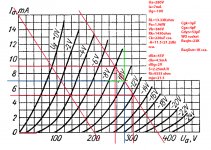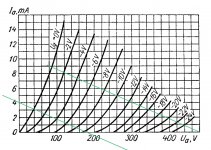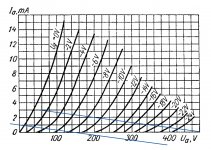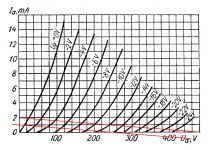I know it's the best version of 6N8S / 1578 tubes and this version made special for Russian military and a longer time of work.
If you're looking on eBay item you can see both.
Without holes
With holes
Sure, if I look on ePay item I can see both, but I still don't understand what makes tubes with holes and metal bases so special.
I'm not sure that is correct English but let me try:
Perforation somewhat reduces millerovkuyu (not translate) capacity, and most importantly improves termobalans (not translate) within the electrode system by reducing the heating traverse Exercise net heat radiated cathode.
I used google translate. I hope this correct?
Perforation somewhat reduces millerovkuyu (not translate) capacity, and most importantly improves termobalans (not translate) within the electrode system by reducing the heating traverse Exercise net heat radiated cathode.
I used google translate. I hope this correct?
Hi
I have both version of 6h8c, metal base and black base.
Metal base it is used but has more amplification and the black base less amplification also less noise but maybe because the amplification is lower.
I like metal base. I have also some 6sn7 a GE pair and a Raython, not tested yet.
The 6h8c I use it on a 6C33C SE amplifier.
I have both version of 6h8c, metal base and black base.
Metal base it is used but has more amplification and the black base less amplification also less noise but maybe because the amplification is lower.
I like metal base. I have also some 6sn7 a GE pair and a Raython, not tested yet.
The 6h8c I use it on a 6C33C SE amplifier.
Where did you get this?
I can read Russian.
Перфорация несколько снижает миллеровкую емкость,а главное улучшает термобаланс внутри электродной системы снижая нагрев траверз упр сетки теплом излучаемым катодом.
from one of Russian forums.
Перфорация несколько снижает миллеровкую емкость,а главное улучшает термобаланс внутри электродной системы снижая нагрев траверз упр сетки теплом излучаемым катодом.
from one of Russian forums.
From Audioportal? 😉
Lot of wisdom! 😀
The author deserves a Noble Premium for discovery of convection in vacuum.
From Audioportal? 😉
Lot of wisdom! 😀
The author deserves a Noble Premium for discovery of convection in vacuum.
Yeah 😀
From Audioportal? 😉
Lot of wisdom! 😀
The author deserves a Noble Premium for discovery of convection in vacuum.
Anatoliy, I know I can always count on you! 😀
So, do you have any experience with these tubes?
Anatoliy, I know I can always count on you! 😀
So, do you have any experience with these tubes?
No. I prefer 6N1P - they are dirt cheap, and have no holes in plates that loose expensive electrons. When properly feed, loaded and biased they sound no worse than 6N8S with any color and material of a socket. 😀
Edit: I have one 6SN7 with a metal base. I am going to crack it, remove old internals, paint golden inside, and solder there 6N16B tube. Then let's ask audiophiless' to try it in their tube rolling apparatus.
Last edited:
Hi guys!
I need a good schemtic (circuit) for tube buffer with tube 6n8s for my CD-player Tehnikcs and audio amplifier M-100.
Thanks for your help!
I need a good schemtic (circuit) for tube buffer with tube 6n8s for my CD-player Tehnikcs and audio amplifier M-100.
Thanks for your help!
Hello everyone.
This subject has already been touched on several times, but remains for me quite confused.
So I'm looking to use my 6n8s (6n7s) to build a full preamp.
After having downloaded different data sheets (soviet, RCA, tungsol), I did my research on the distortion of this tube. I did not find a table on the rate of distortion as a function of Ra and Rk in the data sheets of the manufacturers.
When browsing forums and websites, two speeches stand out:
1 •) A large plate resistance 150kOhms to 250kOhms reduces distortion: indeed the load line tends to be horizontal. But it sits in the knees of the curves.
2 •) A low plate resistance (ex: 47kOhm) tends to increase the current at the anode Ia. indeed the load line intersects the linear part of the curves.
I don't want to do mu follower and other complicated things, but to use my tubes simply and correctly.
The manufacturers give at 300v (voltage that I will use) 3 values of Ra: 50k 100k 250k with for all the same gain: 14. I don't want to have a big tension swing but rather to minimize the distortion and use these tubes in their most linear part possible.
My feeling is that a gate voltage between -2v and -4v and an anode resistor around 50k seems OK. At 100k, the load line intersects the lower part of the curves.
Am I right? What should I choose? Please.
Thank you for your feedback.
This subject has already been touched on several times, but remains for me quite confused.
So I'm looking to use my 6n8s (6n7s) to build a full preamp.
After having downloaded different data sheets (soviet, RCA, tungsol), I did my research on the distortion of this tube. I did not find a table on the rate of distortion as a function of Ra and Rk in the data sheets of the manufacturers.
When browsing forums and websites, two speeches stand out:
1 •) A large plate resistance 150kOhms to 250kOhms reduces distortion: indeed the load line tends to be horizontal. But it sits in the knees of the curves.
2 •) A low plate resistance (ex: 47kOhm) tends to increase the current at the anode Ia. indeed the load line intersects the linear part of the curves.
I don't want to do mu follower and other complicated things, but to use my tubes simply and correctly.
The manufacturers give at 300v (voltage that I will use) 3 values of Ra: 50k 100k 250k with for all the same gain: 14. I don't want to have a big tension swing but rather to minimize the distortion and use these tubes in their most linear part possible.
My feeling is that a gate voltage between -2v and -4v and an anode resistor around 50k seems OK. At 100k, the load line intersects the lower part of the curves.
Am I right? What should I choose? Please.
Thank you for your feedback.
Last edited:
Generally you want Ia to be as high as possible. I would go for 9-10mA, but it'll require much higher B+.
At B+=300V I would go for Ra=30..33k and Ia=5..6mA
At B+=300V I would go for Ra=30..33k and Ia=5..6mA
Hello Marco 🙂
this about 150K-250K Rload for 6SN7 alike tube is abs(wrong)
And 47K Load is also too much.
Based on datasheet of 6N8S I draw some static calculations.
With respect to:
- linear region of the tube
- minimum distortion
- proper gain for preamp stage
With in the max value of the tube.
Also I wrote some basics static tube parameters in operating point.
next step could be to define spice model for the tube and simulate circuit. Before rush into "blind internet" build...
this about 150K-250K Rload for 6SN7 alike tube is abs(wrong)
And 47K Load is also too much.
Based on datasheet of 6N8S I draw some static calculations.
With respect to:
- linear region of the tube
- minimum distortion
- proper gain for preamp stage
With in the max value of the tube.
Also I wrote some basics static tube parameters in operating point.
next step could be to define spice model for the tube and simulate circuit. Before rush into "blind internet" build...
Attachments
Thanks guys for replies.
I understand now values like 10k 30k.
I think i must do some tries
I understand now values like 10k 30k.
I think i must do some tries
Last edited:
Thanks guys for replies.
I understand now values like 10k 30k.
I think i must do some tries
Thanks
These settings Rl=13.5K (27Kohm in parallel) for one section are for V battery of 380V. I think that standard of 450V max voltage will be good for power supply. All Caps.
For good PS I think C-L-C-L-C filter is minimum must to use.
...
Ck is 25V minimum
...
Cout is locked with value of the input R of the next stagee after the preamp.
And it is crucial for good low end response and phase.
(That settings off-course are not only possible solution.You can bias the tube with battery of 9V with slight different working point for the example. The main reason I draw the diagram is constant repetition of too-big-values for Rload for almost every tube. Which is leading to bad sound and most people have forming bad attitude against the tube sound...)
few things:
in parallel, 2 sections, there will be about 500 ohms of outur resistnce of the stage like generator. That is opening good chance to put 1:1 interstage transformer and bring the phase in = phase out, by inverting secondary.
...
The Reqin is actualy max value of the POT at the input. These 22K-25K Log standard value is for one section. For parallel 2 sections (one tube per channel) POT is 1/2 of that value. So it is 10K. That is because of dynamic capacitances wich formed HF filter in konjuction with pot. And it happening in low levels of pot. Because of that we usually have phenommenon of cuttinh High F with low levels reproduction. I made a calc for -3db@131KHz == -0.25db@20KHz, and small phase shift.
.
These values of POT has to be drive by somer low impedance source before preamp (before POT) because pot will terminate output line of the device before preamp.
If it is tuve device ingront the preamp like RIAA or DAC end should be with cathode follower or some buffer at the output.
BUT these values of pot like 3
in parallel, 2 sections, there will be about 500 ohms of outur resistnce of the stage like generator. That is opening good chance to put 1:1 interstage transformer and bring the phase in = phase out, by inverting secondary.
...
The Reqin is actualy max value of the POT at the input. These 22K-25K Log standard value is for one section. For parallel 2 sections (one tube per channel) POT is 1/2 of that value. So it is 10K. That is because of dynamic capacitances wich formed HF filter in konjuction with pot. And it happening in low levels of pot. Because of that we usually have phenommenon of cuttinh High F with low levels reproduction. I made a calc for -3db@131KHz == -0.25db@20KHz, and small phase shift.
.
These values of POT has to be drive by somer low impedance source before preamp (before POT) because pot will terminate output line of the device before preamp.
If it is tuve device ingront the preamp like RIAA or DAC end should be with cathode follower or some buffer at the output.
BUT these values of pot like 3
Thanks ZoranThere are some graphs illustrating why these big values of Rload for this tube are wrong
But why damn it builders are giving such values ?
(And no distortion rate)
Look Rca and the soviet datasheet...
- Home
- Amplifiers
- Tubes / Valves
- Russian 6N8S/1578



